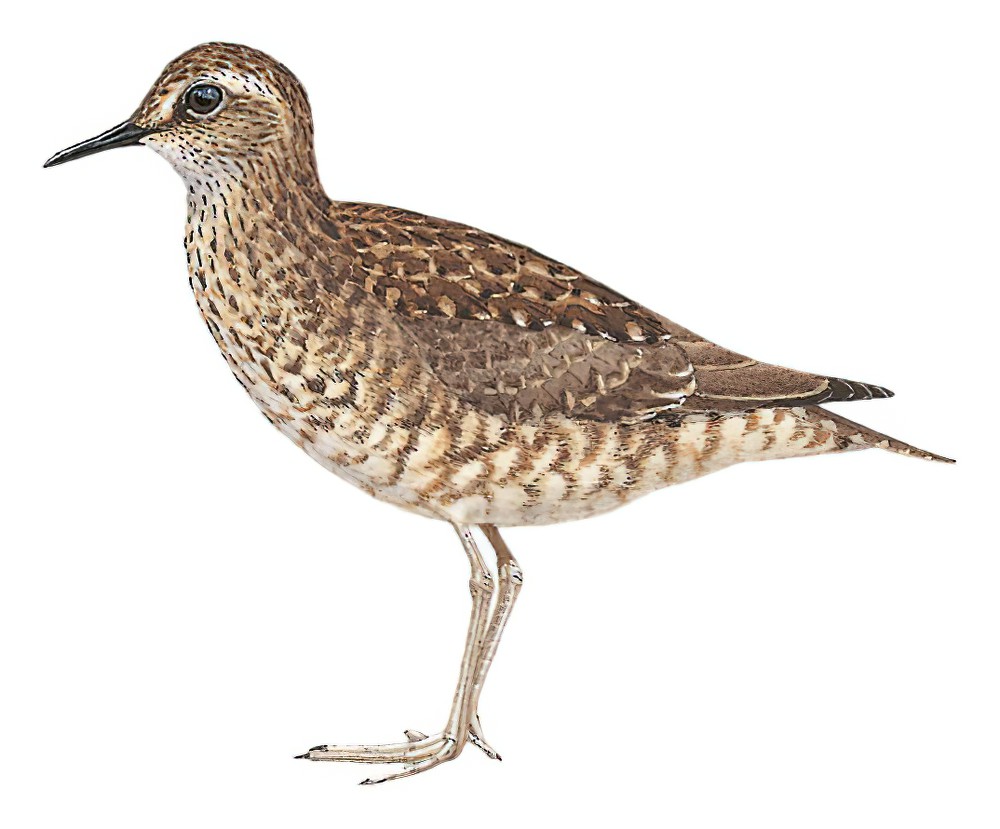Tuamotu Sandpiper / Prosobonia parvirostris

Tuamotu Sandpiper
SCI Name:
Protonym: Tringa parvirostris U.S.Expl.Exped. 8 p.235
Taxonomy: Charadriiformes / Scolopacidae / Prosobonia
Taxonomy Code: tuasan1
Type Locality: Dog [or Honden] and Raraka Islands, Paumotu Group.
Author: Peale
Publish Year: 1848
IUCN Status: Endangered
DEFINITIONS
PROSOBONIA
(Scolopacidae; Ϯ Tahiti Sandpiper P. leucoptera) Johnsgard 1981, is doubtless correct in suggesting that this name may be a misspelling from Gr. προσωπον prosōpon mask, with reference to the dark russet lores, cheeks and forecrown of the Tahiti Sandpiper. However, the name could be a deliberate curtailment of Prosobonasia, as if from Gr. προσο- proso- adjoining, and specific name Aphanapteryx bonasia, Red Rail (an extinct island rail which shared its demise, rufous plumage, and straight bill with the sandpiper ). Bonaparte’s diagnosis implies that this group of sandpipers had been considered close to the Rallidae, but is otherwise infuriatingly clueless. Alternatively, the Gr. προ pro indicates relationship, and the second part of the name (with that stretch of the imagination essential to students of Bonaparte’s work) could be a play on the genus Pisobia Billberg, 1827, sandpiper; "Dans les Échassiers, les Ocydromiens, démembrés des Ralliens, et les Prosoboniens, formés du seul genre Prosobonia, qui a pour type la singulière Tringa leucoptera de la Nouvelle Zélande." (Bonaparte 1850). Recent work suggests that this genus, unique in nectarivory amongst the Charadriiformes, is allied to the turnstones Arenaria.
Var. Prosoponia.
Synon. Aechmorhynchus.
parvirostris
L. parvus small; -rostris -billed < rostrum beak.
● ex “Pato pico pequeño” of de Azara 1802-1805, no. 432 (syn. Anas sibilatrix).
● "54. Tetrao, L. 141. urogallus, L. (major, Br. crassirostris, Brehm. hybridus, L. cum Lyr. tetrice. medius, Leisl. intermedius, Langsd. pseudourogallus, Brehm. maculatus, Brehm. urogalloides, Nilss.) 142. parvirostris, Bp. (urogalloides, Middend.)" (Bonaparte 1856). According to Mlíkovsky 2012, "the Black-billed Capercaillie should be called Tetrao urogalloides Middendorff, 1853, not Tetrao parvirostris Bonaparte, 1856." (syn. Tetrao urogalloides).
UPPERCASE: current genus
Uppercase first letter: generic synonym
● and ● See: generic homonyms
lowercase: species and subspecies
●: early names, variants, mispellings
‡: extinct
†: type species
Gr.: ancient Greek
L.: Latin
<: derived from
syn: synonym of
/: separates historical and modern geographic names
ex: based on
TL: type locality
OD: original diagnosis (genus) or original description (species)












